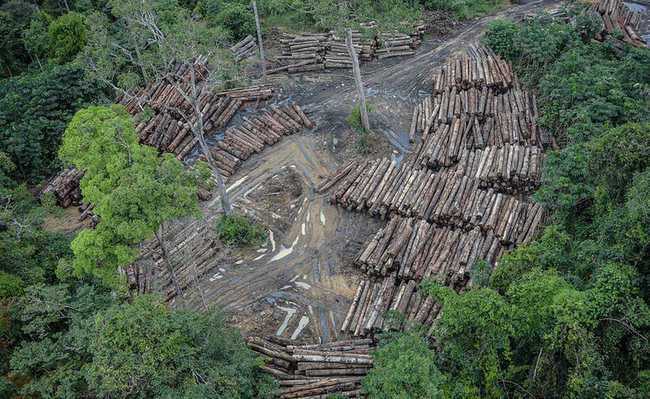What is deforestation?
Deforestation has a devastating impact on biodiversity and intensifies the greenhouse effect

"Pirititi Indigenous Land, Roraima" by Felipe Werneck/Ibama (CC BY-SA 2.0)
Before we define and explain forest deforestation, we need to know: what are forests?
Forests are areas that have a high density of trees, where the crowns touch each other forming a kind of green "roof". They are fundamental to human life. According to data from the United Nations Environment Program (UNEP), around 1.6 billion people earn their living in some activity related to forests, and around 60 million indigenous people around the world depend exclusively on them for their livelihood, in addition to being the habitat of many species of animals and plants.
Now, we can explain what forest deforestation is, which can also be called deforestation or deforestation. We can say that, according to the dictionary, deforestation is "the act that consists in the removal of forest", that is, the total or partial removal of trees, forests and other vegetation from a given region.
Deforestation is one of the most serious environmental problems today, as in addition to devastating forests and natural resources, it compromises the balance of the planet in its various elements, including ecosystems, also seriously affecting the economy and society. In Brazil, there is growing concern about deforestation in the Amazon, which broke records in 2019.

Edited and resized image by Marcin Kempa is available on Unsplash
Causes of deforestation
The causes of deforestation are diverse and, for the most part, composed of human activities that cause or intensify the occurrence of this problem, such as: agricultural expansion (opening up of areas for agriculture, grazing or rural areas waiting for financial recovery), mining activity (areas that are devastated for the installation of equipment and exploration activities for gold, silver, bauxite/aluminium, iron, zinc, etc.), intense and increasing exploitation of natural resources due to the demand for raw material, the growing increased urbanization and increased fires, accidental or intentional.
Consequences and impacts of deforestation
The consequences and impacts generated by deforestation are devastating. And the first one affected is the local biodiversity, because once the forests are destroyed, the habitat of many species, contributing to the death of many animals and even the extinction of endemic types, bringing problems to the food chain and local ecosystems. This loss can even impact economic activities such as hunting and fishing.
Deforestation also has negative consequences on water and soil. As forests are responsible for regulating about 57% of the world's surface freshwater, they contribute by providing moisture to the environment. In other words, removing them implies changing the climate balance in many regions, not to mention the intensification of the greenhouse effect. In addition, they improve land drainage, and their absence intensifies landslides on steeply sloping land, accentuates flooding, facilitates soil erosion and desertification. As a result, soils are deprived of their nutrients, which causes siltation of rivers and lakes, due to the deposit of soil carried in their beds. Deforestation is the main cause of land degradation.
Human beings are another one who suffers the consequences of their own actions, since, as already mentioned, 1.6 billion people today depend, directly or indirectly, on activities related to forests. Man is deprived not only of a potential continuous production of wood, but also of many other valuable natural products, such as fruits, almonds, fibers, resins, oils and medicinal substances, on which humanity depends for its survival.
In Brazil, one of the biggest concerns is with the Amazon. With its 6.9 million square kilometers, the forest suffers from deforestation, which, since 1970, has reached 18% of its territory, an area equivalent to the territories of Rio Grande do Sul, Santa Catarina, Paraná, Rio de Janeiro and Holy Spirit.
- Amazon deforestation: causes and how to fight it
What to do to change this paradigm?
For all these reasons, the UN and other international bodies, as well as numerous regional entities, recognize and summarily emphasize that the solution must take into account local and global factors in a multidisciplinary project articulated on a large scale. Not only scientists, governments, companies and institutions should be involved, but also, and above all, the population, since it is the origin and end of all processes. The way to do this is education and various incentives to clarify the benefits generated by forests and to change ways of thinking and production and consumption habits that lead to deforestation.
The goals established by the United Nations were:
- Reverse the loss of forest cover in the world through sustainable management, protection, restoration and reforestation, and reduce forest degradation;
- Emphasize the economic, social and environmental benefits generated by forests, and improve the living conditions of populations dependent on them;
- Significantly expand the world area of protected and sustainably managed forests, as well as encourage the consumption of forest products from well-managed forests;
- Reverse the decline in official assistance to sustainable projects and mobilize significantly more resources to promote sustainable management.
The Food and Agriculture Organization of the United Nations (FAO) also recommends the following main strategies for the conservation of forests and their good management:
- Create well-planned reforestation projects and invest in environmental services;
- Promote small and medium-scale development projects based on forests, especially for the poorest populations, those who are most dependent on them;
- Promote the use of wood as an energy source and reuse or recycle wood products;
- Improve communication and international cooperation, encouraging research and environmental education, facilitating credits and integrating forestry projects into the macroeconomy.
About 31% of the globe's land surface is still covered by forests in varying degrees of conservation, with approximately 22% of them still in pristine condition, but despite significant surviving coverage, it is estimated that half of the world's forests have already disappeared, given that we urgently need to revert for the good of the planet. To fight deforestation, you can support causes such as the Zero Deforestation movement, consume products from companies with environmental responsibility, spread knowledge on the subject and be aware of political positions related to environmental issues (both in terms of governments and in terms of action).
Watch a video made by Greenpeace about the Zero Deforestation movement!










